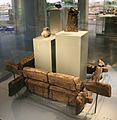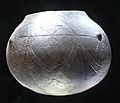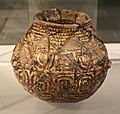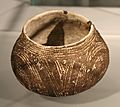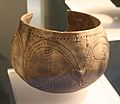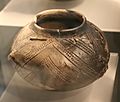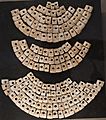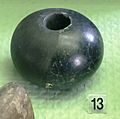Linear Pottery culture facts for kids
The Linear Pottery culture was an important group of people who lived in Europe during the Neolithic period, also known as the later Stone Age. They lived from about 5500 to 4500 BC. This culture is often called LBK for short. You might also hear it called Linear Band Ware or Linear Ceramics because of the way their pottery looked.
Most of the evidence for this culture comes from Central Europe. They were among the first farmers in Europe. The pottery they made, which gives them their name, included simple cups, bowls, vases, and jugs. These pots didn't have handles and were used for cooking or carrying food and drinks. They often had cool line patterns on them.
Contents
Life as Early Farmers
The LBK people lived for about 1000 years, long before people started using bronze. They were farmers, growing crops like wheat, lentils, and peas. They also raised cows and dogs. Sometimes, they would hunt animals like deer in the nearby forests to add to their food.
Daily Food and Health
The food they ate might not have given them enough energy. People from the LBK culture were often not as tall as people who lived before them or as tall as people are today. This could also be because of disease. Illnesses can spread more easily when many people live close together in a village, compared to when people move around a lot. LBK people likely died quite young, often in their twenties or thirties. Many children also did not live to become adults.
If someone was very sick and in a lot of pain, the LBK people might have used a special plant to help ease the pain. They probably also knew how to use wild herbs as medicine to help with some illnesses.
Beliefs and Religion
The LBK people likely believed in a mother goddess. This goddess probably represented the richness and growth of the land they farmed. They believed she helped their crops grow and their animals thrive.
Tools and Technology
Since this was before the Bronze Age or Iron Age, the LBK people didn't have metal tools. Everything they used was made from natural materials. They used stone, wood, and plants like flax, which could be made into clothing. They also used things from animals, such as leather or fur.
They even had sickles, which are tools used for cutting plants, shaped like a half-moon with a handle. But their sickles were made of wood with sharp stone pieces glued into them for cutting.
Homes and Villages
The LBK people lived in large, rectangular houses called longhouses. When archaeologists dig up an area, they often find groups of about six longhouses together. People in these nearby groups probably knew each other well and would share or trade their goods. Their houses were built from wood, mud, and straw. They might have even kept their animals inside the houses with them.
Signs of Conflict
Some LBK settlements have strong walls, called palisades, built around them. These walls were there to protect them from other groups who might attack. Archaeologists have also found skeletons of LBK people with injuries that look like they came from battles. This suggests that there was often fighting between different groups in those times.
Important Places
Some important places where LBK settlements have been found include Nitra in Slovakia, Bylany in the Czech Republic, and Langweiler in Germany.
One very important site is Oslonki in Poland. This was a large, fortified settlement. It had almost 30 longhouses and over 80 graves. This makes it one of the richest sites for archaeological finds in all of Central Europe.
Images for kids
-
Map of European Neolithic at 4500–4000 BC, showing the Linear Pottery culture in bright yellow and green in the middle, over what is now Germany and the Czech Republic.
See also
 In Spanish: Cultura de la cerámica de bandas para niños
In Spanish: Cultura de la cerámica de bandas para niños
















